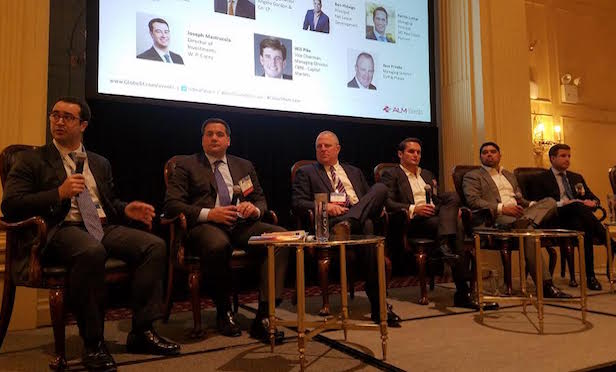 From left: Joseph Mastrocola, Chris Capolongo, Ross Prindle, Patrick Luther, Ben Hidalgo, Will Pike
From left: Joseph Mastrocola, Chris Capolongo, Ross Prindle, Patrick Luther, Ben Hidalgo, Will Pike
NEW YORK CITY—WarnerMedia's double sale leaseback, first in January 2014 at 10 Columbus Circle and then more recently at 30 Hudson Yards, has once again shined a spotlight on this option for financing. The Hudson Yards deal, reportedly exceeding $2 billion, gave real estate owners and businesses a reminder to consider the best way to put their capital to use.
At GlobeSt.com's RealShare 17th Annual Net Lease Conference, speakers on the panel “Sale Leasebacks: 2019 Market Outlook” agreed that now is a good time for these kinds of deals.
“Net lease is a pretty good hedge against recession relative to other asset classes,” said Joseph Mastrocola, director of investments at W. P. Carey. His company particularly favors industrial as just under half of their portfolio by rent is in manufacturing or logistics. He added those assets are not as capital intensive as offices and present a stronger argument for capital investments. Plus, sale leasebacks provide long-term yields.
“Companies that need to generate more sale leaseback proceeds will be more likely to do it,” said Will Pike, vice chairman and managing director at CBRE, capital markets. They provide a strong financing tool for cash hungry companies.
The costs of land are at an all-time high for sale leasebacks, noted Ben Hidalgo, principal at Net Lease Development. Based in TX, his company is a build-to-suit, net lease retail developer. He says it's a challenge for operators wanting to make a profit, with owners of fast food chains wanting to sell them.
In addition to the price for land, construction costs are very high now, added Patrick Luther, managing principal at SRS Real Estate Partners. The return on costs for the developer that is building are so tight, it's making it more difficult to actually pencil projects, he explained.
“If you enter into a recession with a rising interest rate environment institutions are going to be critical to take up this market for certain developers and with sale leasebacks,” Luther stated. But he added the cost of capital with sale leasebacks also depends on looking at the debt market.
Elizabeth Randall, president of Randall Commercial Group, who moderated the discussion, asked with this environment, what are examples of companies looking for sale leasebacks now?
“Cannabis dispensaries are often strapped for cash, so sale leasebacks are a great way to get financing, and people who are doing it are actually getting some pretty good deals,” said Ross Prindle, managing director at Duff & Phelps. The Los Angeles-based cannabis company MedMen last year announced it was selling a significant portion of its real estate assets to the Treehouse REIT in sale leasebacks. This allowed for liquidity and off-balance sheet financing.
Luther pointed out that medical clinics, pet centers and car washes are all active with consolidations and executions of sale leasebacks. Randall then asked what's holding back the market in other sectors?
Chris Capolongo, managing director at Angelo Gordon & Co., commented there's hesitation in committing to a sale leaseback strategy in an environment that is rapidly changing. “Sometimes, they are just not aware, and they need to understand it better. Sometimes, it's not the first priority. They just bought a company and they are fixing operations first and worrying about real estate second,” he opined. “Once they get up to speed, once they understand the math, once they understand the process, it is something people jump at.”
Capolongo pointed to the WarnerMedia Hudson Yard sale leaseback. It makes sense as Related is in the real estate business. On the other side, WarnerMedia freed a considerable amount of cash to pay down debt and invest in its more profitable businesses.
© Touchpoint Markets, All Rights Reserved. Request academic re-use from www.copyright.com. All other uses, submit a request to [email protected]. For more inforrmation visit Asset & Logo Licensing.







